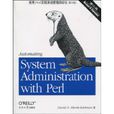《使用Perl實現系統管理自動化》是2010年東南大學出版社出版的圖書,作者是David N.Blank-Edelman。
基本介紹
- 書名:使用Perl實現系統管理自動化
- 又名: Automating System Administration with Perl
- ISBN:7564119284
- 頁數: 639頁
- 出版社:東南大學出版社
- 出版時間:2010年1月1日
- 裝幀:平裝
- 開本:16
- 正文語種:英語
內容簡介,編輯推薦,媒體推薦,作者簡介,目錄,
內容簡介
《使用 Perl實現系統管理自動化(第2版)(影印版)》內容簡介:如果你從事任何系統管理方面的工作,就必須應對日益複雜的工作環境以及對你的時間不斷增加的需求。《使用Perl實現系統管理自動化 第二版》不僅提供了可用於工作的恰當工具,還給出了許多建議,幫助你解決特定問題以及安全地自動處理重複事務。這一版的“水獺書”經過更新和擴充,涵蓋了最新的作業系統、技術和Perl模組,將會幫助你:
* 管理用戶賬戶
* 監測檔案系統和進程
* 處理XML和YAML等格式的配置檔案
* 使用DBI管理資料庫,包括MySQL、MS SQL和Oracle
* 處理LDAP和Active Directory等目錄服務
* 編寫腳本管理電子郵件協定和垃圾郵件
* 高效地創建、處理和分析日誌檔案
* 管理網路名稱和配置服務,包括NIS、DNS和DHCP
* 維護、監測和映射網路服務
* 提高檔案系統、進程和網路的安全性
這一版的附錄中還包含了額外內容,幫助你快速掌握XML/XPath、LDAP、SNMP和SQL等技術。《使用 Perl實現系統管理自動化(第2版)(影印版)》在手並結合Perl,你將花費更少的資源,付出更少的勞動,大大減少煩惱,讓你事半功倍。
編輯推薦
《使用 Perl實現系統管理自動化(第2版)(影印版)》是由東南大學出版社出版的。

媒體推薦
“直到系統管理員閱讀本書前,存在太多的任務本可以(並且應該)自動化完成但卻沒有。Peri是一種強大的工具,David向我們展示了如何讓系統管理員付出更少勞動就能將系統掌控得更好。”
——Peter Baer Galvin,Corporate Technologies 公司首席技術官、IT架構師
作者簡介
David N.Blank-Edelman是美國東北大學計算機與信息科學學院的技術主任,擁有25年在多種平台上的系統/網路管理員經驗。
目錄
Preface
1. Introduction
Automation Is a Must
How Perl Can Help You
This Book Will Show You How
What You Need
Some Notes About the Perl Versions Used for This Book
What About Perl 5.10?
What About Strawberry Perl?
What About Perl 6?
Some Notes About Using Vista with the Code in This Book
Locating and Installing Modules
Installing Modules on Unix
Installing Modules on Win32
It’s Not Easy Being Omnipotent
Don’t Do It
Drop Your Privileges As Soon As Possible
Be Careful When Reading Data
Be Careful When Writing Data
Avoid Race Conditions
.Enjoy
References for More Information
2. Filesystems
Perl to the Rescue
Filesystem Differences
Unix
Windows-Based Operating Systems
Mac OS X
Filesystem Differences Summary
Dealing with Filesystem Differences from Perl
Walking or Traversing the Filesystem by Hand
Walking the Filesystem Using the File::Find Module
Walking the Filesystem Using the File::Find::Rule Module
Manipulating Disk Quotas
Editing Quotas with edquota Trickery
Editing Quotas Using the Quota Module
Editing NTFS Quotas Under Windows
Querying Filesystem Usage
Module Information for This Chapter
References for More Information
3. User Accounts
Unix User Identities
The Classic Unix Password File
Changes to the Password File in BSD 4.4 Systems
Shadow Passwords
Windows-Based Operating System User Identities
Windows User Identity Storage and Access
Windows User ID Numbers
Windows Passwords Don’t Play Nice with Unix Passwords
Windows Groups
Windows User Rights
Building an Account System to Manage Users
The Backend Database
The Low-Level Component Library
The Process Scripts
Account System Wrap-Up
Module Information for This Chapter
References for More Information
Unix Password Files
Windows User Administration
4. User Activity
Process Management
Windows-Based Operating System Process Control
Unix Process Control
File and Network Operations
Tracking File Operations on Windows
Tracking Network Operations on Windows
Tracking File and Network Operations in Unix
Module Information for This Chapter
Installing Win32::Setupsup
References for More Information
5. TCP/IP Name and Configuration Services
Host Files
Generating Host Files
Error-Checking the Host File Generation Process
Improving the Host File Output
Incorporating a Source Code Control System
NIS, NIS+, and WINS
NIS+
Windows Internet Name Server (WINS)
Domain Name Service (DNS)
Generating DNS (BIND) Configuration Files
DNS Checking: An Iterative Approach
DHCP
Active Probing for Rogue DHCP Servers
Monitoring Legitimate DHCP Servers
Module Information for This Chapter
References for More Information
6. Working with Configuration Files
Configuration File Formats
Binary
Naked Delimited Data
Key/Value Pairs
Markup Languages
All-in-One Modules
Advanced Configuration Storage Mechanisms
Module Information for This Chapter
References for More Information
XML and YAML
7. SQL Database Administration
Interacting with a SQL Server from Perl
Using the DBI Framework
Using ODBC from Within DBI
Server Documentation
MySQL Server via DBI
Oracle Server via DBI
Microsoft SQL Server via ODBC
Database Logins
Monitoring Space Usage on a Database Server
Module Information for This Chapter
References for More Information
DBI
Microsoft SQL Server
ODBC
Oracle
8. Email
Sending Mail
Getting sendmail (or a Similar Mail Transport Agent)
Using the OS-Specific IPC Framework to Drive a Mail Client
Speaking the Mail Protocols Directly
Common Mistakes in Sending Email
Overzealous Message Sending
Subject Line Waste
Insufficient Information in the Message Body
Fetching Mail
Talking POP3 to Fetch Mail
Talking IMAP4rev1 to Fetch Mail
Processing Mail
Dissecting a Single Message
Dissecting a Whole Mailbox
Dealing with Spam
Support Mail Augmentation
Module Information for This Chapter
References for More Information
9. Directory Services
What’s a Directory?
Finger: A Simple Directory Service
The WHOIS Directory Service
LDAP: A Sophisticated Directory Service
LDAP Programming with Perl
The Initial LDAP Connection
Performing LDAP Searches
Entry Representation in Perl
Adding Entries with LDIF
Adding Entries with Standard LDAP Operations
Deleting Entries
Modifying Entry Names
Modifying Entry Attributes
Deeper LDAP Topics
Putting It All Together
Active Directory Service Interfaces
ADSI Basics
Using ADSI from Perl
Dealing with Container/Collection Objects
Identifying a Container Object
So How Do You Know Anything About an Object?
Searching
Performing Common Tasks Using the WinNT and LDAP Namespaces
Working with Users via ADSI
Working with Groups via ADSI
Working with File Shares via ADSI
Working with Print Queues and Print Jobs via ADSI
Working with Windows-Based Operating System Services via ADSI
Module Information for This Chapter
References for More Information
LDAP
ADSI
10. Log Files
Reading Text Logs
Reading Binary Log Files
Using unpack()
Calling an OS (or Someone Else’s) Binary
Using the OS’s Logging API
Structure of Log File Data
Dealing with Log File Information
Space Management of Logging Information
Log Parsing and Analysis
Writing Your Own Log Files
Logging Shortcuts and Formatting Help
Basic/Intermediate Logging Frameworks
Advanced Logging Framework
Module Information for This Chapter
References for More Information
11. Security
Noticing Unexpected or Unauthorized Changes
Local Filesystem Changes
Changes in Data Served Over the Network
Noticing Suspicious Activities
Local Signs of Peril
Finding Problematic Patterns
Danger on the Wire, or “Perl Saves the Day”
Preventing Suspicious Activities
Suggest Better Passwords
Reject Bad Passwords
Module Information for This Chapter
References for More Information
12. SNMP
Using SNMP from Perl
Sending and Receiving SNMP Traps, Notifications, and Informs
Alternative SNMP Programming Interfaces
Module Information for This Chapter
References for More Information
13. Network Mapping and Monitoring
Network Mapping
Discovering Hosts
Discovering Network Services
Physical Location
Presenting the Information
Textual Presentation Tools
Graphical Presentation Tools
Monitoring Frameworks
Extending Existing Monitoring Packages
What’s Left?
Module Information for This Chapter
References for More Information
14. Experiential Learning
Playing with Timelines
Task One: Parsing crontab Files
Task Two: Displaying the Timeline
Task Three: Writing Out the Correct XML File
Putting It All Together
Summary: What Can We Learn from This?
Playing with Geocoding
Geocoding from Postal Addresses
Geocoding from IP Addresses
Summary: What Can We Learn from This?
Playing with an MP3 Collection
Summary: What Can We Learn from This?
One Final Exploration
Part One: Retrieving the Wiki Page with WWW::Mechanize
Part Two: Extracting the Data
Part Three: Geocoding and Mapping the Data
Summary: What Can We Learn from This?
Remember to Play
Module Information for This Chapter
Source Material for This Chapter
A. The Eight-Minute XML Tutorial
B. The 10-Minute XPath Tutorial
C. The 10-Minute LDAP Tutorial
D. The 15-Minute SQL Tutorial
E. The Five-Minute RCS Tutorial
F. The Two-Minute VBScript-to-Perl Tutorial
G. The 20-Minute SNMP Tutorial
Index

